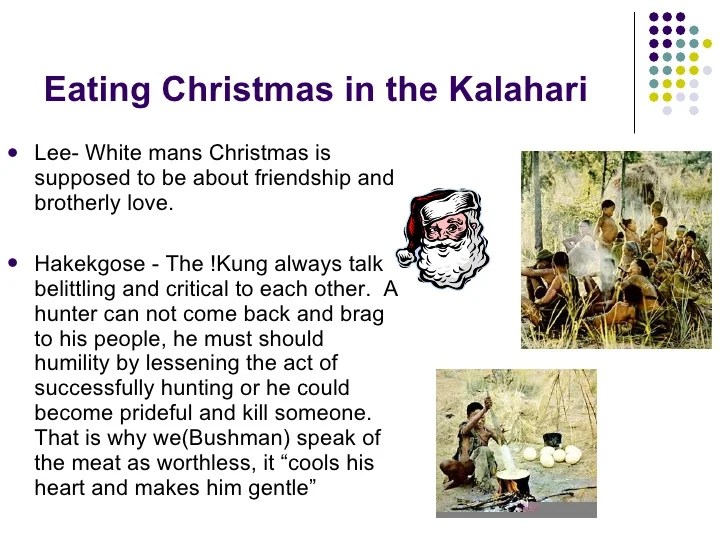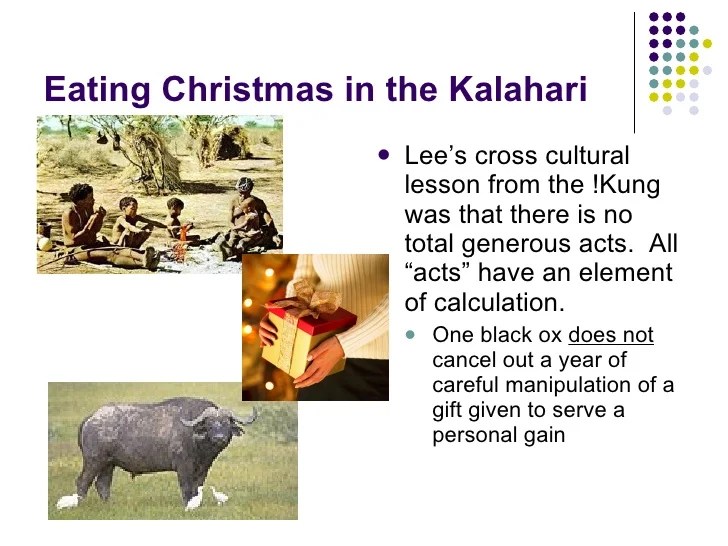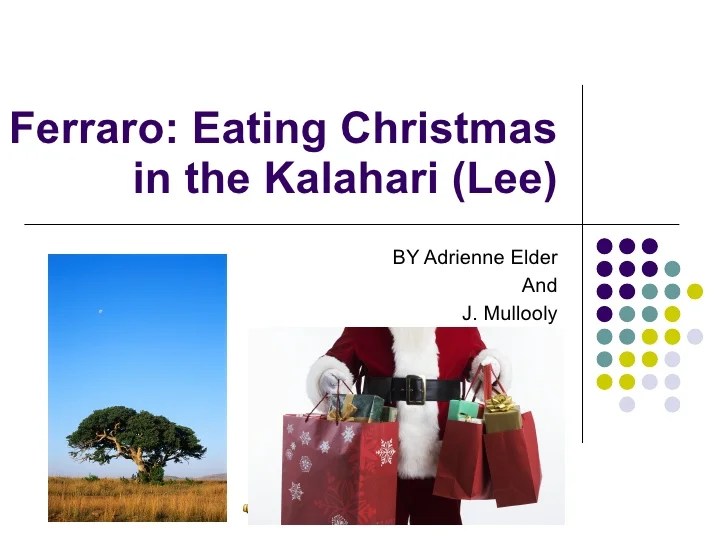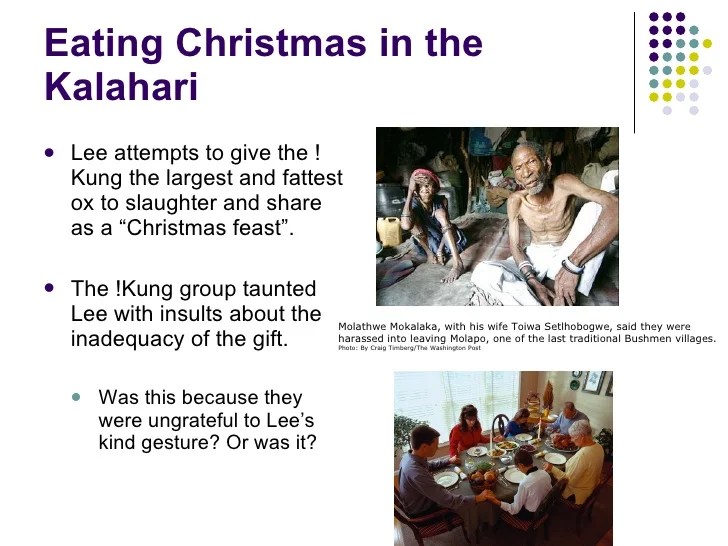Eating Christmas in the Kalahari offers a captivating glimpse into the unique fusion of traditional customs and contemporary adaptations that characterize festive celebrations in this extraordinary desert region. Immerse yourself in the vibrant tapestry of indigenous Christmas practices, culinary delights, and environmental considerations that shape the Kalahari Christmas experience.
From the vast expanse of the Kalahari Desert to the rich cultural heritage of its indigenous communities, this exploration unveils the essence of Christmas in a setting both remote and captivating. Discover how traditional foods, rituals, and community bonds intertwine with modern influences, shaping a celebration that is both authentic and evolving.
Kalahari Desert

The Kalahari Desert is a vast, semi-arid region located in Southern Africa, covering parts of Botswana, Namibia, and South Africa. It is characterized by its unique ecosystem, which has adapted to the harsh conditions of the desert environment.
The Kalahari Desert is known for its vast expanses of sand dunes, which cover approximately 70% of the region. These dunes are formed by the erosion of sandstone and limestone, and they can reach heights of up to 300 meters.
The desert also features a variety of other landscapes, including grasslands, savannas, and salt pans.
Climate
The Kalahari Desert has a hot, dry climate, with average temperatures ranging from 20 to 35 degrees Celsius. The region receives an average of 250 to 500 millimeters of rainfall per year, which is highly variable and often unpredictable.
Geography
The Kalahari Desert is a relatively flat region, with an average elevation of around 900 meters above sea level. The highest point in the desert is Mount Auas, which rises to a height of 2,485 meters. The desert is bordered by the Orange River to the west, the Limpopo River to the east, and the Zambezi River to the north.
Biodiversity
The Kalahari Desert is home to a wide variety of plant and animal life. The vegetation is primarily composed of grasses, shrubs, and trees, which have adapted to the harsh conditions of the desert. The desert is also home to a variety of animals, including lions, leopards, elephants, and giraffes.
Challenges and Adaptations of Life in the Kalahari
The Kalahari Desert presents a number of challenges to life. The lack of water, extreme temperatures, and limited food resources make it difficult for plants and animals to survive. However, the organisms that have adapted to the desert have developed a number of unique strategies for survival.
For example, many plants in the Kalahari have developed deep root systems that allow them to access water from deep underground. Some plants also have thick, waxy leaves that help to reduce water loss through evaporation. Animals in the Kalahari have also adapted to the harsh conditions of the desert.
Many animals are nocturnal, which helps them to avoid the heat of the day. Some animals also have long legs that allow them to travel long distances in search of food and water.
Christmas Traditions in the Kalahari
Christmas in the Kalahari is a unique blend of traditional customs and external influences. Indigenous communities have developed their own distinctive ways of celebrating the holiday, while also incorporating elements from other cultures.
One of the most important traditional Christmas customs in the Kalahari is the gathering of family and friends. On Christmas Eve, families often gather around a fire to sing carols and share stories. They may also participate in a traditional dance called the “motsepe,” which is performed to celebrate the birth of Jesus.
On Christmas Day, families typically attend church services and then gather for a feast. The feast usually includes traditional dishes such as “seswaa” (a meat stew) and “mabele” (a porridge made from sorghum). After the feast, families often spend the rest of the day playing games and visiting with friends and relatives.
Evolution of Christmas Traditions in the Kalahari
Over time, Christmas traditions in the Kalahari have evolved to reflect the changing demographics of the region. The arrival of missionaries and European settlers introduced new customs, such as the Christmas tree and the exchange of gifts. These customs have been gradually adopted by indigenous communities, but they have also been adapted to reflect the unique culture of the Kalahari.
Influence of External Cultures on Christmas Celebrations in the Kalahari
The influence of external cultures on Christmas celebrations in the Kalahari is evident in the use of Christmas trees, the exchange of gifts, and the singing of carols. These customs have been adopted from European and American cultures, but they have been adapted to reflect the unique culture of the Kalahari.
For example, Christmas trees are often decorated with traditional African ornaments, and carols are often sung in the local language.
Food and Cuisine

Christmas in the Kalahari is a time for celebration and feasting. Traditional foods play a central role in the festivities, with families and communities coming together to share special dishes.
One of the most popular Christmas dishes in the Kalahari is mopane worms. These caterpillars are harvested from mopane trees and are considered a delicacy. They are typically dried and then fried or boiled. Mopane worms are a good source of protein and are often served with pap, a porridge made from maize meal.
Another popular dish is seswaa, a type of beef stew. Seswaa is made by cooking beef in a large pot over an open fire. The beef is then shredded and served with pap or mieliepap, a porridge made from maize meal and water.
Christmas is also a time for baking in the Kalahari. Families often make koeksisters, a type of fried dough that is coated in syrup. Koeksisters are a popular treat and are often served with tea or coffee.
Comparison of Traditional Christmas Foods
The following table compares traditional Christmas foods in the Kalahari with those from other regions:
| Region | Traditional Christmas Foods |
|---|---|
| Kalahari | Mopane worms, seswaa, koeksisters |
| United States | Turkey, ham, mashed potatoes, stuffing |
| United Kingdom | Roast beef, Yorkshire pudding, Christmas pudding |
| Germany | Roast goose, potato dumplings, red cabbage |
| France | Foie gras, oysters, bûche de Noël |
Cultural Significance

Christmas holds immense cultural significance for indigenous communities in the Kalahari Desert, serving as a time to celebrate, preserve traditions, and strengthen community bonds.
The festival plays a crucial role in preserving cultural heritage, as it provides a platform to showcase traditional dances, music, and storytelling. Through these practices, indigenous communities pass down their cultural knowledge and values to younger generations, ensuring their preservation and continuity.
Role in Community Bonding
Christmas is a time for communities to come together, fostering a sense of unity and belonging. It provides an opportunity for families and friends to gather, share meals, and engage in festive activities, strengthening the social fabric of the community.
Contemporary Adaptations: Eating Christmas In The Kalahari

Christmas celebrations in the Kalahari have undergone significant adaptations in recent times, influenced by the forces of modernization, technology, globalization, and tourism. These changes have both preserved traditional customs and introduced new elements, creating a unique blend of old and new.
Technology and Globalization
The advent of technology and globalization has had a profound impact on Christmas celebrations in the Kalahari. Mobile phones and the internet have facilitated communication and information sharing, allowing people to stay connected with family and friends both near and far.
Social media platforms have become a popular way to share Christmas greetings and photos, and to learn about different Christmas traditions around the world.
Tourism
Tourism has also played a role in shaping Christmas celebrations in the Kalahari. The presence of tourists has led to an increased awareness of traditional Christmas customs, and has encouraged local communities to preserve and showcase their unique cultural heritage.
In some cases, tourism has also led to the commercialization of Christmas, with the sale of Christmas-themed souvenirs and the organization of special events.
Incorporation of Contemporary Elements
Indigenous communities in the Kalahari have creatively incorporated contemporary elements into their Christmas celebrations, while still maintaining the core values and traditions of the holiday. For example, some communities have begun to use Christmas trees, which are not native to the Kalahari, as a symbol of the holiday.
Others have adopted Christmas carols and hymns from other cultures, while still performing traditional songs and dances.
Environmental Considerations

Christmas celebrations in the Kalahari, while cherished by communities, can potentially impact the fragile desert ecosystem. Increased consumption, waste generation, and travel during the festive season contribute to environmental concerns.
Sustainable Practices and Initiatives
Recognizing the importance of environmental stewardship, communities in the Kalahari have adopted sustainable practices to minimize their ecological footprint. These include:
- Reducing waste through recycling and composting programs.
- Conserving water by using low-flow appliances and rainwater harvesting systems.
- Promoting the use of renewable energy sources, such as solar and wind power.
- Encouraging sustainable tourism practices to minimize the impact on wildlife and natural habitats.
Adapting Christmas Traditions, Eating christmas in the kalahari
Christmas traditions in the Kalahari have also been adapted to promote environmental conservation. For example:
- Using natural materials like dried grasses and palm leaves for decorations.
- Opting for eco-friendly gift wrapping made from recycled paper or reusable fabrics.
- Serving traditional dishes that utilize locally sourced ingredients, reducing transportation emissions.
- Encouraging community gatherings and celebrations that foster a sense of unity and reduce individual consumption.
By embracing these sustainable practices and adapting traditions, communities in the Kalahari can celebrate Christmas while preserving the delicate balance of their unique desert ecosystem.
Tourism and Cultural Exchange
Tourism plays a vital role in promoting cultural exchange during Christmas in the Kalahari. It provides opportunities for visitors to immerse themselves in the unique traditions and customs of the indigenous communities while fostering mutual understanding and respect.
For indigenous communities, tourism can generate economic benefits through the sale of traditional crafts, cultural experiences, and guided tours. It can also create employment opportunities and contribute to the preservation of cultural heritage. However, tourism also presents challenges, such as the potential for cultural commodification and environmental degradation.
Guidelines for Respectful and Sustainable Tourism
- Respect local customs and traditions, including dress codes and cultural protocols.
- Seek permission before taking photographs or recording videos of people or sacred sites.
- Choose tour operators that prioritize responsible and sustainable practices.
- Minimize environmental impact by using reusable items, conserving water, and disposing of waste properly.
- Support local businesses and initiatives that promote cultural preservation and community well-being.
FAQ Explained
What are the unique characteristics of the Kalahari Desert?
The Kalahari Desert is known for its vast, semi-arid landscape, characterized by rolling sand dunes, sparse vegetation, and extreme temperatures. It is home to a diverse range of wildlife, including lions, elephants, giraffes, and zebras.
How have Christmas traditions evolved in the Kalahari?
Christmas traditions in the Kalahari have evolved over time, incorporating influences from both indigenous cultures and external sources. While traditional practices such as storytelling and communal feasts remain central, the celebration has also adopted elements of Western Christmas, such as gift-giving and Santa Claus.
What are some of the traditional foods enjoyed during Christmas in the Kalahari?
Traditional Christmas foods in the Kalahari include dishes such as mopane worms, ostrich meat, and millet porridge. These dishes are often prepared using local ingredients and reflect the region’s culinary heritage.
How does Christmas contribute to cultural preservation in the Kalahari?
Christmas plays a vital role in preserving cultural traditions and fostering community bonds in the Kalahari. It provides an opportunity for indigenous communities to gather, share stories, and pass on their cultural knowledge to younger generations.
What are some of the environmental considerations associated with Christmas celebrations in the Kalahari?
Christmas celebrations in the Kalahari can have potential environmental impacts, such as waste generation and increased energy consumption. However, communities are increasingly adopting sustainable practices, such as using eco-friendly decorations and promoting responsible tourism, to minimize their environmental footprint.